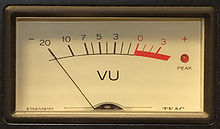
A volume unit (VU) meter or standard volume indicator (SVI) is a device displaying a representation of the signal level in audio equipment.
The original design was proposed in the 1940 IRE paper, A New Standard Volume Indicator and Reference Level, written by experts from CBS, NBC, and Bell Telephone Laboratories.[1] The Acoustical Society of America then standardized it in 1942 (ANSI C16.5-1942)[2][3] for use in telephone installation and radio broadcast stations.
Consumer audio equipment often features VU meters, both for utility purposes (e.g. in recording equipment) and for aesthetics (in playback devices).

The original VU meter is a passive electromechanical device, namely a 200 μA DC d'Arsonval movement ammeter fed from a full-wave copper-oxide rectifier mounted within the meter case. The mass of the needle causes a relatively slow response, which in effect integrates or smooths the signal, with a rise time of 300 ms. This has the effect of averaging out peaks and troughs of short duration, and reflects the perceived loudness of the material more closely than the more modern and initially more expensive PPM meters. For this reason many audio practitioners prefer the VU meter to its alternatives, though the meter indication does not reflect some of the key features of the signal, most notably its peak level, which in many cases, must not pass a defined limit.
0 VU is equal to +4 dBu, or 1.228 volts RMS, a power of about 2.5 milliwatts when applied across a 600-ohm load. 0 VU is often referred to as "0 dB".[4] The meter was designed not to measure the signal, but to let users aim the signal level to a target level of 0 VU (sometimes labelled 100%), so it is not important that the device is non-linear and imprecise for low levels[according to whom?]. In effect, the scale ranges from −20 VU to +3 VU, with −3 VU right in the middle (half the power of 0 VU). Purely electronic devices may emulate the response of the needle; they are VU-meters in as much as they respect the standard.
In the broadcast industry, loudness monitoring was standardized, in 2009 in the United States by the ATSC A/85, in 2010 in Europe by the EBU R 128, in 2011 in Japan by the TR-B32, and in 2010 in Australia by the OP-59.
- ^ Chinn, H. A. "A New Standard Volume Indicator and Reference Level" (PDF).
- ^ McKnight, John. G. (Jay) (2006-07-27). "Some Questions and Answers on the Standard Volume Indicator ("vu meter")" (PDF). Audio Engineering Society.
- ^ "VU Meters Information". Engineering 360. Retrieved 2017-03-23.
- ^ VU Meter.